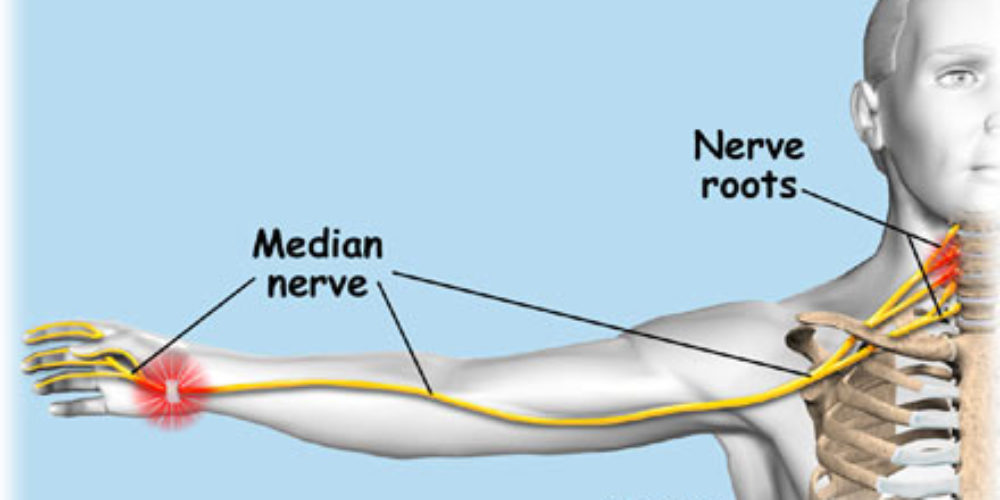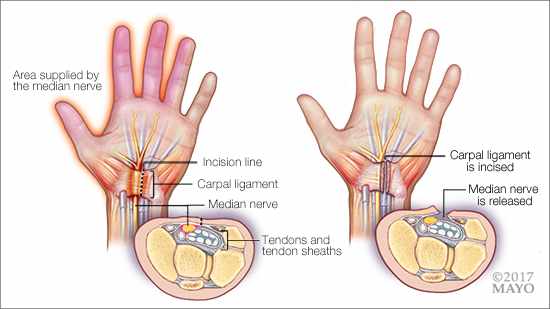One of the secondary conditions that may develop during pregnancy is Carpal Tunnel Syndrome. Some may think this condition only occurs in old people, or those who use their hands a lot during the day. Well, add preggo women to that list as well. As an occupational therapist, I’ve seen this presented in clinic numerous times with patients. As a mom in her third pregnancy, I’ve had it three times. Therefore, I’ve decided to breakdown the facts about CTS, why you can get it while your pregnant, and what you can do about it to alleviate the symptoms.
What is Carpal Tunnel Syndrome?
First of all, carpal tunnel is an opening in between the bones in your wrist, through which the Median Nerve runs. It starts at the neck, travels down your arm and ends at your hand. In general, if your hand is in a forward bent position for an extended period of time (e.g. typing on a computer or sleeping in a curled position), this nerve is compressed and you get that tingly/numb sensation. This is Carpal Tunnel Syndrome. Here are some references from Three Rivers Orthopedics and Mayo Clinic.

Median Nerve
Photo Credit: Three Rivers Orthopedics


Carpal Tunnel Anatomy
Photo Credit: MayoClinic

Why do pregnant women get carpal tunnel syndrome?
As a pregnant woman is steadily gaining weight, she her blood volume and fluid retention increases (almost 50% more than when she wasn’t pregnant!) This fluid can collect anywhere in the body, including the delicate tissue surrounding the carpal tunnel. This puts pressure on the median nerve and leads to tingling, numbness and sometimes pain in the hand and/or wrist.
The good news is that it is usually a transient condition, which resolves after delivery or within the first few months once swelling has gone down. The other good news is that there are things you can do to alleviate the symptoms of CTS to make pregnancy a little more bearable.
What can be done to treat CTS symptoms?
As an occupational therapist, there are a few conservative techniques I have recommended to patients with mild CTS.
-
Positioning
-As mentioned before, many non-pregnant people can get CTS just by daily tasks that place their wrist in a flexed position.
Sleeping- If you sleep curled up in a ball with your hands tucked under your pillow or into your chest, this may contribute to CTS symptoms. Consider repositioning yourself, but if you fall back into that position while you sleep, you may want to consider wearing splints at night (see #5)
Work- If you sit at a desk and/or computer most of the day, check your hand positioning. If you practice good ergonomics, your wrist should be in a neutral or slightly extended position. Consider how you wrist also, if your hand is in a flexed position
Childcare- If you have little ones that you are picking up or carrying around a lot during the day, your wrist may be in a repetitively flexed position. Consider switching sides or bearing their load in the middle of your body so that your wrist is more in neutral -
Nutritional Modifications to Reduce
Hydrate- It may seem counterintuitive, but by drinking more water, you are helping those tissues to return fluids to the veins and thus reducing inflammation
Reduce salt and sugar intake- UGHH more diet restrictions??!! Trust me, I’m guilty guilty guilty of binging on both of these when I’m pregnant (and when I’m not). But consider it an option to get that fluid compression off of your tiny median nerve.
Swelling all over the body is a very common occurrence in pregnancy, especially in the third trimester. Here are some other general tips to follow to reduce edema in pregnancy. -
Exercises/Stretches.
There are many variations of exercises and stretches to open up the space in the carpal tunnel and alleviate the pressure on the median nerve.
Stop sign pull-back- Extend your arm out in front of you as if to say “stop”, then gently pull back your hand using your other hand so that you feel the stretch in your forearm.
Prayer position swing- Put your hands together palms touching at chest level, elbows out to the side, and hold this position to feel the stretch in both forearms. You can also gently move your palms together across your chest, armpit to armpit, to deepen the stretch.
Median Nerve Glide Exercises- These are a series of positions performed with your entire arm which, when done in this specific sequence, can really open up the carpal tunnel and relieve pressure on the median nerve. There are many variations, but here is one I frequently use:
-
Wearing a Splint
Wearing a pre-fabricated wrist cock-up splint. It puts your wrist in that optimal neutral position and takes pressure off of the median nerve.They can be worn during the activities that cause the wrist flexion (e.g. computer use, sleeping, childcare activities.) It can be found in most pharmacies, medical supply stores, or my personal favorite, AMAZON! I wore one on each wrist when my CTS got really bad during my first pregnancy and helped a lot.

Hope this helps clarify some concerns or questions that you may have about Carpal Tunnel Syndrome, especially for you pregnant mamas!! If you have more severe symptoms than the ones described above or prolonged past the postpartum period, you should consult with your physician for further evaluation and treatment.



